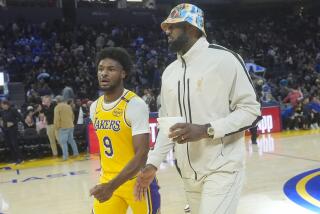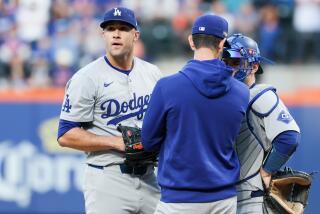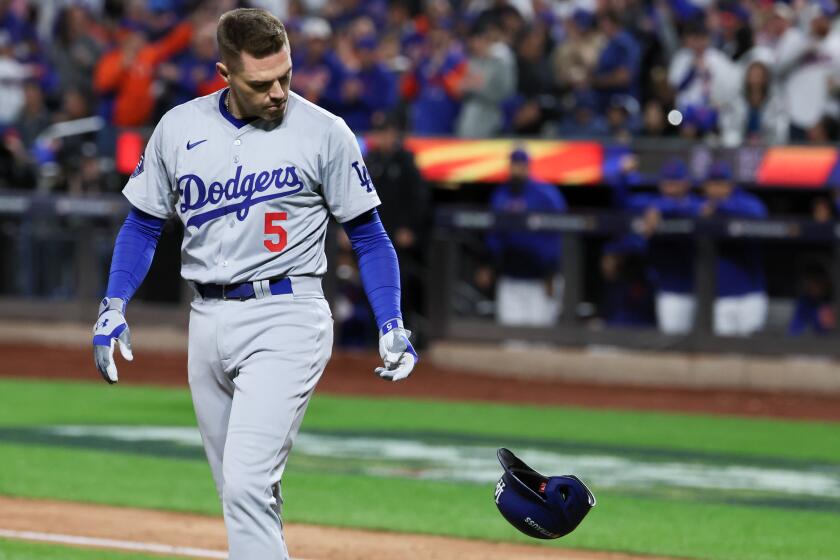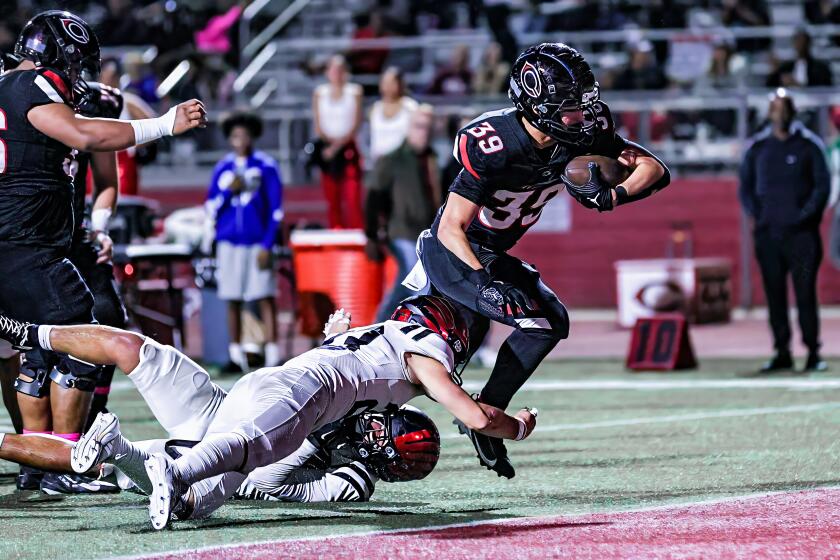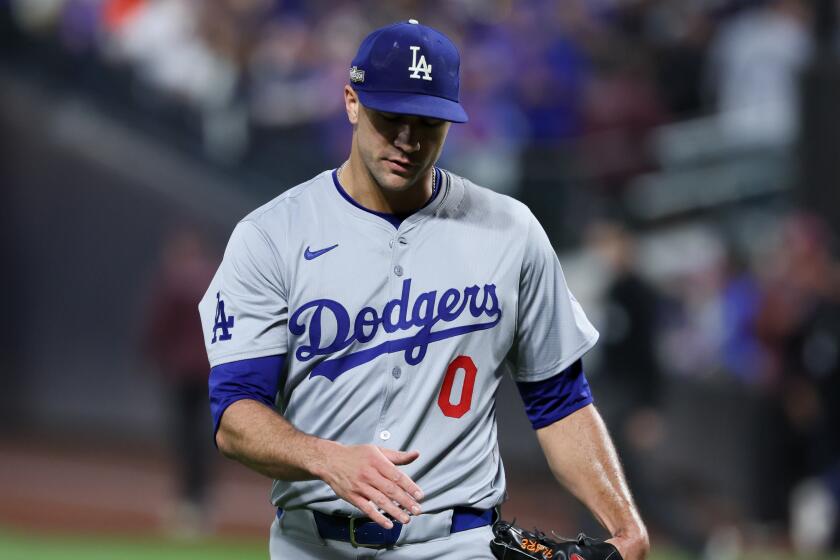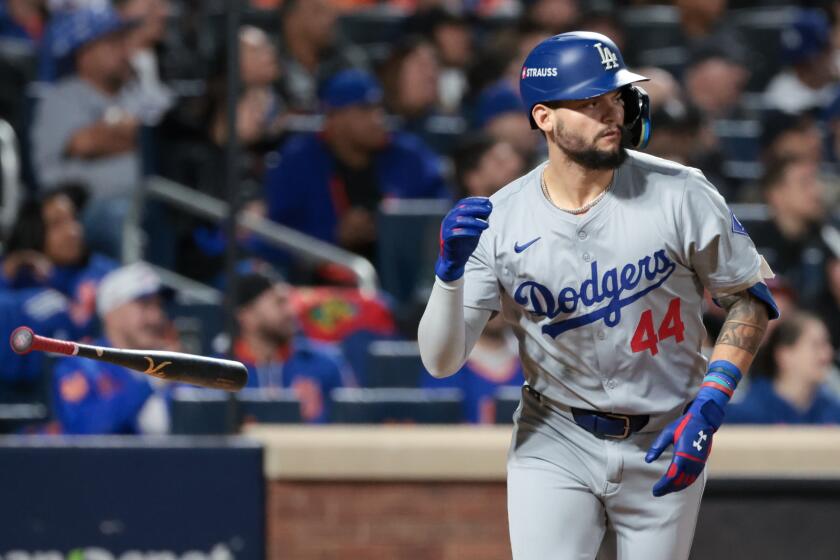Oxy Professor’s TV Show to Probe the Mystery of Champions
What is that mystery force that once enabled Jack Youngblood to play football on a broken leg? That allowed Jan Stephenson to channel out the world and sink the putt that won the 1983 Lady Keystone Open? That pushed Alberto Salazar over Heartbreak Hill and through the tape in the 1982 Boston Marathon?
Ken Atchity, a professor of comparative literature at Occidental College, has produced the pilot for a television show called “BreakThrough” that attempts to answer those questions and explain what makes the contemporary athletic champion tick.
“Our show is a show for a whole new generation,” Atchity said. “Not only of television watchers who are more aware of psychology than ever before, but also a whole new generation of athletes who are aware of all this.”
Stephenson, who hosts the pilot show with former Raider receiver Bob Chandler, feels there is room for an educational talk show concentrating on the athletic community.
Just ‘a Thin Line’
“For some reason there’s a thin line between why one athlete is better than the other, and I think it would be good to document that and see if we could learn something from it,” she said. “There are so many athletes with great personalities and they have something to offer.”
The program is not a run-of-the-mill half-hour of fun and games because it moves away from the standard interview-and-highlights format and dispenses with the customary byplay between host and guest. Although the discussion centers around sports, its highbrow content may not necessarily appeal to the Lite Beer set.
“It’s not for a jock audience, the kind of thing that people watch in a bar,” warned Atchity, the show’s executive producer. “It’s too intellectual a show for that. But the didactic factor is not what comes across. All the education is done low-key. What comes across is excitement and inspiration. There’s never a dull moment.”
Atchity, who has spent several years studying the creative process, teaches creative writing in addition to one of Occidental’s two journalism courses. In his 14 years as a member of the faculty, he has been exposed to numerous debates about evolution and it was the question of evolution that gave him the idea for his television project.
The thought came to him 2 1/2 years ago after he and colleagues finished a discussion of the technology and psychology of contemporary sports.
Individual Breakthroughs
“I always thought it was ironic that the people who debate about the pros and cons of evolution don’t ever notice something that’s right under their noses,” he explained.
“In the world of sports, there’s evidence that ever since records have been kept, records have been broken. And every time a record is broken, we all evolve. But we evolve not in a regular, steady, gradual way. We evolve in a breakthrough, when one single individual on the cutting edge breaks across that cutting edge.”
Some prime examples of this phenomenon can be found in swimming and track and field, where world records are shattered every year owing to everything from technique to training methods. After some of the performances at last year’s Summer Olympics, only Bob Beamon’s 1968 record long jump seems safe for a while.
Atchity explained how the champion athlete thinks about his performance. “He imagines the process, in his mind, of doing it. Then, if he does it, it is no longer a question of can it be done. The question for the rest of the generation suddenly becomes: How did he do it?
He ‘Took the Risk’
“Then we go back and study the videotapes to see how he did it and then, within a year, other people are matching his record because we know it can be done. But he’s the one who made the breakthrough. He’s the one who took the risk, imagined that it could be done without knowing for sure.”
Atchity and veteran Los Angeles television journalist Maury Green, who wrote the show’s script, try to deliver what the title “Breakthrough” implies. The show deals with the 12 steps toward breakthrough that Atchity says everybody goes through, from the moment a person has a dream until the moment that the dream becomes a reality.
“What the show is really about is that moment of breakthrough at which an individual is for one brief moment at the pinnacle of human potential,” Atchity said. “He’s standing up there completely alone for the only time in his life, doing this thing that no one has ever done before. And that’s what motivates not only the great athlete but people in all walks of life--to achieve.”
Production Company
The program is one of 50 television and literary projects produced at L/A House Productions, a company Atchity started in 1982. Steve Hochman, who earned his master’s degree at Occidental, was hired as the associate producer on “BreakThrough.” Original music for the show was composed by Adam Holtzman, another graduate of the school. Two or three of the assistant producers also were Occidental students.
The Occidental connection “was just a natural tie-in because of the people I had around me,” Atchity said.
He and Hochman have interviewed 80 professional and amateur champions and record breakers, including Chandler, Youngblood, Stephenson, Salazar, Johnny Bench, Magic Johnson, Mary Decker Slaney, Gordie Howe and Len Dawson.
The producers were excited by a number of revelations during their research. One was that Youngblood, who continued playing in a Rams-Dallas game after suffering a hairline fracture, and Stephenson, who once contemplated quitting because her putting was off, used the same method in balancing the conscious and the unconscious to overcome deficiencies.
The key, Stephenson told Atchity, is turning off the conscious 10% that involves pain, nerves and the significance of the moment and turning on the unconscious 90% that contains the experience and the natural ability already ingrained in the athlete.
Used Same Techniques
“The one thing all had in common was that they used the same techniques to reach breakthrough and that all were motivated in the same way,” observed Atchity, who has designed a course at Occidental called “Evolution: Progress or Breakthrough?” and is writing a book with the same title as the TV show.
Because of a funding problem, only a pilot episode has been filmed. Among the guests on that show were Youngblood, “Anatomy of an Illness” author Dr. Norman Cousins, powerboat driver Betty Cook and Gregory Raiport, a Soviet sports psychologist who defected and is living in Beverly Hills.
Atchity, who credited the long-running and syndicated “Greatest Sports Legends” with providing his financial inspiration, is aiming his show at a broad audience, women and men ranging in age from 17 to 65. From a commercial standpoint, he said, the prime target originally involved upwardly mobile males from 25 to 45. However, when he screened the pilot in Los Angeles, the South and the Midwest, Atchity discovered that women liked it as much as men.
More to Read
Go beyond the scoreboard
Get the latest on L.A.'s teams in the daily Sports Report newsletter.
You may occasionally receive promotional content from the Los Angeles Times.

